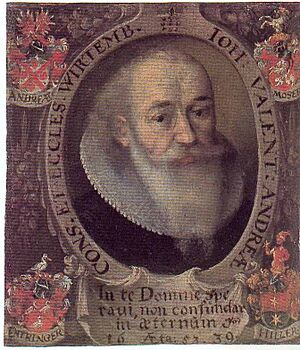Johannes Valentinus Andreae facts for kids
Quick facts for kids
Johannes Valentinus Andreae
|
|
|---|---|

Johannes Valentinus Andreae
|
|
| Born | 17 August 1586 Herrenberg, Duchy of Württemberg
|
| Died | 27 June 1654 (aged 67) |
| Parent(s) | Johannes Andreae (1554–1601) Maria Moser |
Johannes Valentinus Andreae (born August 17, 1586 – died June 27, 1654) was a German thinker and church leader. He is famous for possibly writing a mysterious old book called The Chymical Wedding of Christian Rosenkreutz in 1459. This book became very important for a group of ideas known as Rosicrucianism, which was a popular but secret movement across Europe at the time.
Andreae was also a key person in a movement that wanted to improve Germany and Europe through better education and science. This movement believed that learning and new discoveries were the way to make countries successful. However, some of their ideas were a bit mystical or secret. This was partly because it was risky to share new thoughts openly back then. People sometimes pretended to be part of secret groups to protect their ideas.
Contents
A Look at Andreae's Life
Andreae was born in Herrenberg, a town in what was then the Duchy of Württemberg. His father, Johannes Andreae, was a church leader. His mother, Maria Moser, later became a court pharmacist in Tübingen.
Early Studies and Travels
Young Andreae studied theology (the study of religion) and natural sciences from 1604 to 1606. He became friends with Christoph Besold, who got him interested in secret or hidden knowledge. Around 1605, he wrote an early version of "The Chemical Wedding of Christian Rosekreutz."
He faced some trouble and was not allowed to finish his final exams for church service. This was probably because he put an insulting note on a chancellor's door. After this, he taught young noblemen and traveled with them. They hiked through Switzerland, France, Austria, and Italy. He visited Dillingen, a strong center for the Jesuits, a Catholic religious order. He did not agree with their views. In 1608, he returned to Tübingen. There, he met Tobias Hess, a doctor interested in future predictions. Andreae traveled again from 1610 to 1612.
Becoming a Church Leader
In 1612, Andreae went back to Tübingen to continue his theology studies. After passing his final exam in 1614, he became a deacon in Vaihingen an der Enz. In 1620, he became a priest in Calw.
In Calw, he worked to improve schools and help people in need. He started groups for charity and support. He even planned a "Christian Union" in 1628. Calw was badly damaged in the Battle of Nördlingen (1634) and suffered from a terrible sickness. Andreae helped raise money and rebuild the town.
In 1639, he became a preacher at the royal court in Stuttgart. He also became a church councilor. In this role, he pushed for big changes to make the church better. He also became a spiritual guide to a princess of Württemberg.
Later Years and Contributions
Andreae supported the Tübinger Stift. This was a special school and living place for students. It was run by the Lutheran Church in Germany. It trained Protestant pastors. Famous people like Johannes Kepler studied there.
In 1646, Andreae joined the Fruchtbringende Gesellschaft ("Fruitbearing Society"). This was a group of important German writers and scholars. He was given the nickname der Mürbe ("the soft"). In 1650, he became the head of the monasterial school Bebenhausen. In 1654, he became the abbot (head) of the evangelical monasterial school of Adelberg. He passed away in Stuttgart that same year.
Andreae and Rosicrucianism
Andreae's exact role in the start of the Rosicrucian ideas is a bit unclear. In his own life story, he said that The Chymical Wedding was one of his works. He called it a "ludibrium", which might mean a joke or a satire. In another book from 1617, he said he wrote this fake document when he was young, around 1605.
Later in his life, Andreae seemed to make fun of alchemy (an old form of chemistry). He put it in the same group as music, art, theater, and astrology, calling them "less serious" sciences. It is not fully clear why he said these things. Maybe he felt pressure from church leaders. Or perhaps his own religious beliefs had changed.
Later, Andreae said he was a very religious and traditional Lutheran. He said he had nothing to do with the two main writings of the secret Rosicrucian society. It seems his main goal was to create a "Christian Society." This was a group of learned people who wanted to live a spiritual life. He hoped they would start a second Reformation (a big change in the church).
His ideas greatly inspired Protestant thinkers in the early 1600s. He seems to have inspired the "Christian Union" started in Nuremberg in 1628. This group was made up of important citizens and churchmen. Another similar group, called Antilia, developed during the Thirty Years' War. Its founders were inspired by Andreae's writings and by Francis Bacon's ideas about experimental science. They even tried to start a colony on an island.
Works by Johannes Valentinus Andreae
- Compendium Mathematicum (1614)
- Chymische Hochzeit Christiani Rosencreutz Anno 1459 ("The Chymical Wedding of Christian Rosencreutz"), published anonymously (1616)
- Menippus (1617)
- Invitatio Fraternitatis Christi (1617–1618)
- Peregrini in patria errores (1618)
- Reipublicae Christianopolitanae descriptio ("Description of the Republic of Christianopolis") (1619)
- Turris Babel (1619)
- De curiositatis pernicie syntagma (1620)
See also
- Esoteric Christianity
- Kabbalah
- Lectorium Rosicrucianum
- Rosicrucianism
- Rosicrucian Fellowship
- Rosicrucian Manifestos

